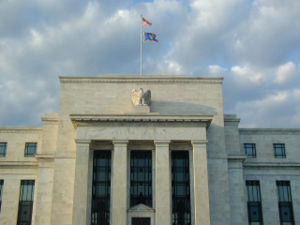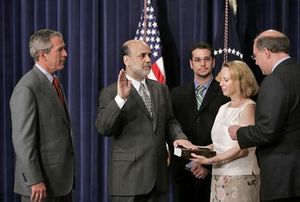Federal Reserve System: Difference between revisions
imported>Kjetil Ree m (→Organization) |
imported>Kjetil Ree |
||
| Line 28: | Line 28: | ||
==Subtopics== | ==Subtopics== | ||
*[[Federal Reserve Act]] | |||
*[[Federal Open Market Committee]] | |||
*[[Federal funds rate]] | |||
*[[Federal Reserve Note]] | |||
*[[Fractional-reserve banking]] | *[[Fractional-reserve banking]] | ||
==Selected external links== | ==Selected external links== | ||
Revision as of 18:40, 26 June 2007

The Federal Reserve System is the central bank of The United States. It is also known as The Federal Reserve, or more informally as The Fed. The current chairman of the Board of Governors and thus the Federal Reserve's leader is Ben Bernanke.
Organization
The Federal Reserve is an independent agency of the United States federal government. Congress has a supervising role, but does not interfere on a daily basis. The chairman of the Federal Reserve is reporting to Congress biannually, but it is usually working closer with The Department of the Treasury and the president. Even though The Fed has an independent status, its independence might be revoked by Congress if Congress wishes to.[1]
The Federal Reserve System is divided into twelve districts, each district having one central bank (called a Federal Reserve Bank). This unique system came as a compromise between those who wanted a strong, federal central bank and those who wanted to continue with the decentralized system in place before 1913.

The Board of Governors is administrating the system. The board is also responsible for the formulation of monetary policy, and for regulating the Federal Reserve Banks and U.S. commercial banks. The seven members of the board are appointed by the president and confirmed by the Senate. The terms span several presidential and congressional terms, so that the board is autonomous. The chairman serves four-year terms, and can be reappointed.
Congress is not funding the Federal Reserve, so that the Fed is free from political pressure. The Fed's main sources of income are the trade of government securities and the making of short term loans to depository institutions. After the Federal Reserve pays its expenses, the rest of the earnings are transfered to the Treasury. About 95 percent of the Reserve Banks' net earnings have been paid into the Treasury since the Federal Reserve System began operations in 1914. In 2003, the Federal Reserve paid approximately $22 billion to the Treasury. The member banks receive an annual divident of 6 percent as specified by law. The Board of Governors conduct an audit of the Reserve Banks annually.[2]
An important part of the Fed is the Federal Open Market Committee (FOMC). The FOMC is responsible for buying and selling government securities, and is therefore controlling the money supply of the United States.
A commercial bank may be a member of the Federal Reserve. Such banks are called member banks. 3000 of America's 8000 banks are members. Nationally chartered banks are required to be members, but it is voluntary for state banks, upon meeting certain standards.[3]
History
The Federal Reserve Banks
What a Federal Reserve Bank does
References
- Citations
- ↑ Tucker, Irvin B (2006) Survey of Economics. Page 358. Thomson South-Western, Mason, OH. ISBN 032431972
- ↑ Fox, Lynn S. et al. (2005) The Federal Reserve System: Purposes and Functions. Page 19-20. Board of Governors of the Federal Reserve System, Washington, DC.
- ↑ Federal Reserve Bank of Dallas: Understanding the Fed
Subtopics
- Federal Reserve Act
- Federal Open Market Committee
- Federal funds rate
- Federal Reserve Note
- Fractional-reserve banking